ABOUT
REMOTE CONTROL SYSTEMS...
An Abridged History (and the Future) of Home Control
Chapter 4 – Automation Platforms
- The Rise of the Machines
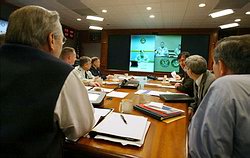 In the tradition
of piling one technology on another, the next step in control evolution
arose in the commercial world for running business and government conference
centers. Here, price is nearly no object, because one sucessful presentation
can earn millions, or redirect the fate of countries. So the problems
of multi-device control have been beaten into submission by brute force,
creating ultra-reliable if single-minded systems. Despite incredible
prices, these AV automation platforms have migrated to the high-end
consumer market.
In the tradition
of piling one technology on another, the next step in control evolution
arose in the commercial world for running business and government conference
centers. Here, price is nearly no object, because one sucessful presentation
can earn millions, or redirect the fate of countries. So the problems
of multi-device control have been beaten into submission by brute force,
creating ultra-reliable if single-minded systems. Despite incredible
prices, these AV automation platforms have migrated to the high-end
consumer market.
Due to the somewhat
unreliable nature of IR control, two other control schemes have held
sway in the professional ranks of control systems – radio frequency
(“RF”) and RS-232 (a computer cable communication protocol).
Only higher grade equipment uses such systems because they are more
expensive to implement, but they provide much more reliable and precise
control with feedback on status. Sometimes used is “two-way IR”
for a degree of interactivity between the control device and the controlled
equipment, but this scheme doubles the likelihood of error on every
command because the controller and the controlled must stay in synchronization
via the optical link.
New on the scene
is a move toward Internet Protocol (IP) communications for advanced
wired control. Because IP uses a standard computer network connection,
can work at world-wide distances, and is very fast for moving any amount
of information bidirectionally, it is increasingly becoming the connection
of choice for complex control.
For the new breed
of commercial and high-end home systems, a touch-screen is used for
input to a real microcomputer that delivers complex-as-ya-wanna-be macros
to devices via reliable two-way links. With the tight relationship between
controller and device, the state of the devices can be determined, and
correct commands are reliably issued.
At last, all is
well.
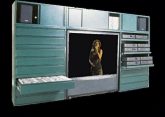 Well…
not quite. In order to preserve the versatility that the residential
environment demands, the architecture of the typical home theater control
automation platform is nearly indistinguishable from that of the universal
remote that it replaces. Macros of commands specific to the devices
in the system are linked together into chains that represent desired
behavior of the devices. Technology assures reliable execution. But
the conceptualization of what the user wants still resides in the head
of the user. The touch panels make it easy to read and find the buttons
that take you to the controls that perform the actions that cause the
devices to operate in the manner you intend. Wow. At the core, it remains
device-centric, perfectly easy and clear, but only if you already knew
what you were doing. Well…
not quite. In order to preserve the versatility that the residential
environment demands, the architecture of the typical home theater control
automation platform is nearly indistinguishable from that of the universal
remote that it replaces. Macros of commands specific to the devices
in the system are linked together into chains that represent desired
behavior of the devices. Technology assures reliable execution. But
the conceptualization of what the user wants still resides in the head
of the user. The touch panels make it easy to read and find the buttons
that take you to the controls that perform the actions that cause the
devices to operate in the manner you intend. Wow. At the core, it remains
device-centric, perfectly easy and clear, but only if you already knew
what you were doing.
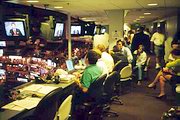 Today,
you can find any number of integrators who will build a custom control
interface for you and your specific system. It will be a one-of-a-kind
creation, with buttons labeled exactly as you ask that do just what
you tell them you want. It might even have pretty pictures as backgrounds.
Using today’s common programming tools, complex installations
become fairly monumental individual works of art. The more equipment
and rooms are added, the larger this programming load becomes. And like
art, it’s difficult to change and adapt a finished work to accommodate
a new taste. Each site is a custom design, with new programming required
for every specified feature and device. And since it is made just for
you, any changes you want after the fact will require a programming
re-write with high expense and delay, even if the original programmer
is around to do it. If not, you’ll probably have to start over
with a new programmer. Custom features are just a matter of money and
time – lots of each. It’s not unusual for a cinema-grade
custom control program to cost over $50,000 for the software alone,
and take three months of development before installation, plus weeks
of on-site tweaks afterwards. Today,
you can find any number of integrators who will build a custom control
interface for you and your specific system. It will be a one-of-a-kind
creation, with buttons labeled exactly as you ask that do just what
you tell them you want. It might even have pretty pictures as backgrounds.
Using today’s common programming tools, complex installations
become fairly monumental individual works of art. The more equipment
and rooms are added, the larger this programming load becomes. And like
art, it’s difficult to change and adapt a finished work to accommodate
a new taste. Each site is a custom design, with new programming required
for every specified feature and device. And since it is made just for
you, any changes you want after the fact will require a programming
re-write with high expense and delay, even if the original programmer
is around to do it. If not, you’ll probably have to start over
with a new programmer. Custom features are just a matter of money and
time – lots of each. It’s not unusual for a cinema-grade
custom control program to cost over $50,000 for the software alone,
and take three months of development before installation, plus weeks
of on-site tweaks afterwards.
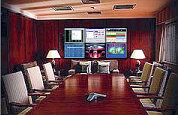 These
factors have made development and support for residential customers
into a time and money nightmare. Many initially profitable residential
AV system integrators have become victims of their success. Support
for existing installations can take so much work that building new customer
sites becomes impossible, and their practice goes under, leaving the
customers without support for their unique creations. These
factors have made development and support for residential customers
into a time and money nightmare. Many initially profitable residential
AV system integrators have become victims of their success. Support
for existing installations can take so much work that building new customer
sites becomes impossible, and their practice goes under, leaving the
customers without support for their unique creations.
Even with all the
resources and money available for the highest-end installations, the
problem of multi-room distribution of TV is seldom addressed. Often,
the “solution” is to pipe the satellite and cable TV feeds
to every room and duplicate the receivers to avoid the problem. But
the clutter, expense, and confusion of operation remain.
What has worked
for commercial environments has not worked for the home. As we witnessed
by watching “The Osbournes” on MTV, even the very rich can
have what they consider to be mediocre, incomprehensible, and unreliable
home theater control systems. Mere mortals never had a chance at all.
Until now.
History of Remote Control -Introduction
Chapter 1 – From Communications
to Music
Chapter 2 – TV goes Mobile
Chapter 3 – One Remote,
Two Remote, Three Remote, Four…
This Chapter – Automation Platforms
– The Rise of the Machines
Chapter 5 – The Next
Generation – User and Content Centric Control
Chapter 6 – Multi-zone
and Theater Convergence
|
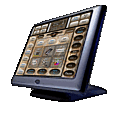









 In the tradition
of piling one technology on another, the next step in control evolution
arose in the commercial world for running business and government conference
centers. Here, price is nearly no object, because one sucessful presentation
can earn millions, or redirect the fate of countries. So the problems
of multi-device control have been beaten into submission by brute force,
creating ultra-reliable if single-minded systems. Despite incredible
prices, these AV automation platforms have migrated to the high-end
consumer market.
In the tradition
of piling one technology on another, the next step in control evolution
arose in the commercial world for running business and government conference
centers. Here, price is nearly no object, because one sucessful presentation
can earn millions, or redirect the fate of countries. So the problems
of multi-device control have been beaten into submission by brute force,
creating ultra-reliable if single-minded systems. Despite incredible
prices, these AV automation platforms have migrated to the high-end
consumer market.
 Well…
not quite. In order to preserve the versatility that the residential
environment demands, the architecture of the typical home theater control
automation platform is nearly indistinguishable from that of the universal
remote that it replaces. Macros of commands specific to the devices
in the system are linked together into chains that represent desired
behavior of the devices. Technology assures reliable execution. But
the conceptualization of what the user wants still resides in the head
of the user. The touch panels make it easy to read and find the buttons
that take you to the controls that perform the actions that cause the
devices to operate in the manner you intend. Wow. At the core, it remains
device-centric, perfectly easy and clear, but only if you already knew
what you were doing.
Well…
not quite. In order to preserve the versatility that the residential
environment demands, the architecture of the typical home theater control
automation platform is nearly indistinguishable from that of the universal
remote that it replaces. Macros of commands specific to the devices
in the system are linked together into chains that represent desired
behavior of the devices. Technology assures reliable execution. But
the conceptualization of what the user wants still resides in the head
of the user. The touch panels make it easy to read and find the buttons
that take you to the controls that perform the actions that cause the
devices to operate in the manner you intend. Wow. At the core, it remains
device-centric, perfectly easy and clear, but only if you already knew
what you were doing. Today,
you can find any number of integrators who will build a custom control
interface for you and your specific system. It will be a one-of-a-kind
creation, with buttons labeled exactly as you ask that do just what
you tell them you want. It might even have pretty pictures as backgrounds.
Using today’s common programming tools, complex installations
become fairly monumental individual works of art. The more equipment
and rooms are added, the larger this programming load becomes. And like
art, it’s difficult to change and adapt a finished work to accommodate
a new taste. Each site is a custom design, with new programming required
for every specified feature and device. And since it is made just for
you, any changes you want after the fact will require a programming
re-write with high expense and delay, even if the original programmer
is around to do it. If not, you’ll probably have to start over
with a new programmer. Custom features are just a matter of money and
time – lots of each. It’s not unusual for a cinema-grade
custom control program to cost over $50,000 for the software alone,
and take three months of development before installation, plus weeks
of on-site tweaks afterwards.
Today,
you can find any number of integrators who will build a custom control
interface for you and your specific system. It will be a one-of-a-kind
creation, with buttons labeled exactly as you ask that do just what
you tell them you want. It might even have pretty pictures as backgrounds.
Using today’s common programming tools, complex installations
become fairly monumental individual works of art. The more equipment
and rooms are added, the larger this programming load becomes. And like
art, it’s difficult to change and adapt a finished work to accommodate
a new taste. Each site is a custom design, with new programming required
for every specified feature and device. And since it is made just for
you, any changes you want after the fact will require a programming
re-write with high expense and delay, even if the original programmer
is around to do it. If not, you’ll probably have to start over
with a new programmer. Custom features are just a matter of money and
time – lots of each. It’s not unusual for a cinema-grade
custom control program to cost over $50,000 for the software alone,
and take three months of development before installation, plus weeks
of on-site tweaks afterwards. These
factors have made development and support for residential customers
into a time and money nightmare. Many initially profitable residential
AV system integrators have become victims of their success. Support
for existing installations can take so much work that building new customer
sites becomes impossible, and their practice goes under, leaving the
customers without support for their unique creations.
These
factors have made development and support for residential customers
into a time and money nightmare. Many initially profitable residential
AV system integrators have become victims of their success. Support
for existing installations can take so much work that building new customer
sites becomes impossible, and their practice goes under, leaving the
customers without support for their unique creations.